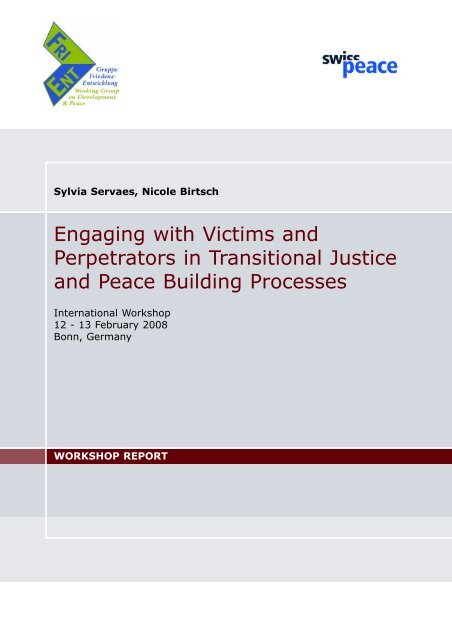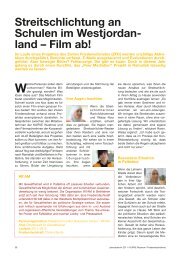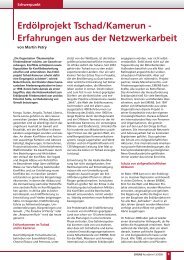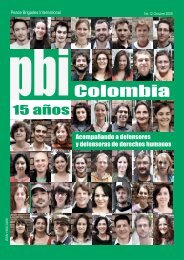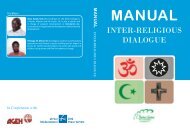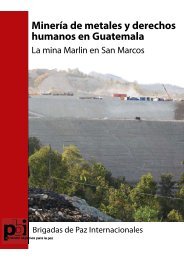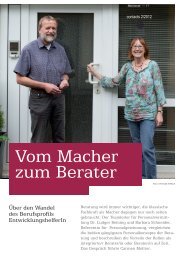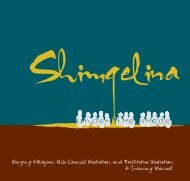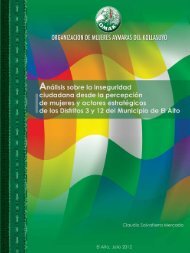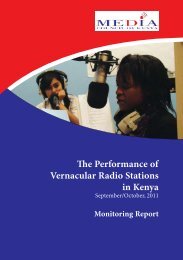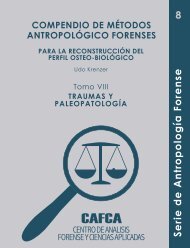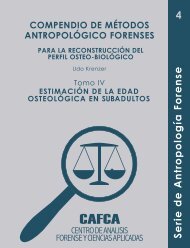Engaging with Victims and Perpetrators in Transitional ... - FriEnt
Engaging with Victims and Perpetrators in Transitional ... - FriEnt
Engaging with Victims and Perpetrators in Transitional ... - FriEnt
- No tags were found...
Create successful ePaper yourself
Turn your PDF publications into a flip-book with our unique Google optimized e-Paper software.
Sylvia Servaes, Nicole Birtsch<strong>Engag<strong>in</strong>g</strong> <strong>with</strong> <strong>Victims</strong> <strong>and</strong><strong>Perpetrators</strong> <strong>in</strong> <strong>Transitional</strong> Justice<strong>and</strong> Peace Build<strong>in</strong>g ProcessesInternational Workshop12 - 13 February 2008Bonn, GermanyWORKSHOP REPORT
<strong>FriEnt</strong>/KOFF Workshop Report<strong>FriEnt</strong>The Work<strong>in</strong>g Group on Development <strong>and</strong> Peace (<strong>FriEnt</strong>) is an association of sevenGerman governmental <strong>and</strong> non-governmental organisations work<strong>in</strong>g <strong>in</strong> the fieldof development cooperation <strong>and</strong> peace build<strong>in</strong>g. <strong>FriEnt</strong> fosters jo<strong>in</strong>t learn<strong>in</strong>gamongst its members, provides <strong>in</strong>formation, capacity build<strong>in</strong>g, <strong>and</strong> advice <strong>and</strong>supports network<strong>in</strong>g <strong>and</strong> cooperation.<strong>FriEnt</strong>’s members are: Federal M<strong>in</strong>istry for Economic Cooperation <strong>and</strong>Development (BMZ) | Church Development Service (EED) | Gesellschaft fürTechnische Zusammenarbeit (GTZ) | He<strong>in</strong>rich-Böll-Stiftung (hbs) | CatholicCentral Agency for Development Aid (KZE) / Misereor | Civil Peace Service Group(Konsortium ZFD) | Platform for Peaceful Conflict Management / Institute forDevelopment <strong>and</strong> Peace (INEF).KOFFThe Center for Peacebuild<strong>in</strong>g (KOFF) was founded at swisspeace 2001 by theFederal Department of Foreign Affairs (DFA) <strong>and</strong> various Swiss non-governmentalorganizations (NGOs). KOFF contributes actively to develop<strong>in</strong>g the conceptual<strong>and</strong> operative coherence of Swiss peace policy. It develops networks, providesanalyses <strong>and</strong> offers <strong>in</strong>formation, tra<strong>in</strong><strong>in</strong>g <strong>and</strong> advisory service on strategies,programs <strong>and</strong> methodologies to all relevant Swiss governmental <strong>and</strong> nongovernmentalactors.AuthorsSylvia Servaes, Nicole BirtschImpr<strong>in</strong>t© Work<strong>in</strong>g Group on Development <strong>and</strong> Peace (<strong>FriEnt</strong>)KOFF SwisspeaceISSN: 1861-8618Responsible under German Press Law: Natascha Zupan<strong>FriEnt</strong>KOFF/swisspeacec/o BMZ, Adenauerallee 139 - 141 Sonnenbergstrasse 1753113 Bonn 3000 Bern 7, Switzerl<strong>and</strong>Tel. +49-228-535-3259 Tel.: +41-31-330-1073Fax. +49-228-535-3799 Fax.: +41-31-330-1213frient@bmz.bund.deKOFF@swisspeace.chwww.frient.de/enwww.swisspeace.ch2
<strong>FriEnt</strong>/KOFF Workshop ReportContents1. Preface ________________________________________ 22. <strong>Victims</strong> <strong>and</strong> perpetrators – a challenge for transitionaljustice <strong>and</strong> development ___________________________ 32.1. A conceptual framework for engag<strong>in</strong>g <strong>with</strong> victims <strong>and</strong>perpetrators _________________________________________ 32.2. Identities ascribed, identities transformed: Psychosocialfoundations of victim <strong>and</strong> perpetrator categories <strong>and</strong> theirtransformation _______________________________________ 53. <strong>Transitional</strong> Justice Mechanisms: Victim orientation –perpetrator orientation? ___________________________ 73.1. The Right to Justice: <strong>Victims</strong>’ needs <strong>and</strong> perpetrators’accountability ________________________________________ 73.2. The Right to Know: <strong>Victims</strong>, perpetrators <strong>and</strong> hierachies of pa<strong>in</strong><strong>and</strong> responsibility <strong>in</strong> Northern Irel<strong>and</strong> _____________________ 83.3. The Right to Reparation: A basis for transform<strong>in</strong>g victim <strong>and</strong>perpetrator identities? ________________________________ 104. Transformation of identities? The guarantee of nonrecurrence_____________________________________124.1. Return<strong>in</strong>g to the community: Re-<strong>in</strong>tegrat<strong>in</strong>g ex-combatants <strong>in</strong>Colombia___________________________________________ 124.2. Economic <strong>and</strong> social re<strong>in</strong>tegration of vulnerable groups – genocidesurvivors, ex-prisoners <strong>and</strong> ex-combatants ________________ 144.3. Struggl<strong>in</strong>g <strong>in</strong> peacetime: Ex-combatants as peace builders____ 155. Strategic Options for Development <strong>and</strong> Peace Build<strong>in</strong>gPractitioners ___________________________________ 165.1. Matters of context____________________________________ 175.2. Elements for consideration _____________________________ 176. Appendix ______________________________________ 19
<strong>FriEnt</strong>/KOFF Workshop Report1 . P r e f a c e<strong>Engag<strong>in</strong>g</strong> <strong>with</strong> victims <strong>and</strong> perpetrators is probably one of the most sensitive <strong>and</strong>complex issues for external actors work<strong>in</strong>g on development <strong>and</strong> peace build<strong>in</strong>g. Itstarts <strong>with</strong> def<strong>in</strong><strong>in</strong>g certa<strong>in</strong> groups as victims or perpetrators <strong>in</strong> highly complex<strong>and</strong> politicised contexts, <strong>in</strong>volves legal questions <strong>and</strong> moral dilemmas, <strong>and</strong> maytouch on the vision an organisation is striv<strong>in</strong>g to realise.<strong>Transitional</strong> Justice <strong>and</strong> peace build<strong>in</strong>g processes provide a range of mechanismsto deal <strong>with</strong> past atrocities <strong>and</strong> pave the way for build<strong>in</strong>g a society based onpeace <strong>and</strong> justice. However, projects often tend to simplify categories of victims<strong>and</strong> perpetrators. Moreover, they overlook the necessity that peace build<strong>in</strong>gprocesses also have to transform these categorisations <strong>and</strong> build a basis for newidentities beyond that of the past.In our <strong>in</strong>ternational workshop, jo<strong>in</strong>tly organised by the Work<strong>in</strong>g Group forDevelopment <strong>and</strong> Peace (<strong>FriEnt</strong>) <strong>and</strong> the Center for Peacebuild<strong>in</strong>g (KOFF) atswisspeace, we discussed some of these challenges <strong>and</strong> identified ways of deal<strong>in</strong>g<strong>with</strong> them. Questions <strong>in</strong>cluded: How may transitional justice mechanisms take<strong>in</strong>to consideration victims <strong>and</strong> perpetrators as two – sometimes heavily<strong>in</strong>tertw<strong>in</strong>ed – social groups <strong>in</strong> post-conflict societies? How can the design of suchmechanisms contribute to transform the identities of victims <strong>and</strong> perpetrators?How are these considerations relevant to decisions development <strong>and</strong> peaceorganisations have to take?Participants from development <strong>and</strong> peace build<strong>in</strong>g organisations as well asresearch <strong>in</strong>stitutions shared their respective experiences. Selected projects <strong>and</strong>approaches from different organisations <strong>and</strong> contexts provided the basis for adiscussion on challenges <strong>and</strong> practice oriented options.This document presents the ma<strong>in</strong> results of the presentations <strong>and</strong> debates.Furthermore, it tries to p<strong>in</strong>po<strong>in</strong>t a number of po<strong>in</strong>ts to keep <strong>in</strong> m<strong>in</strong>d for decisionmak<strong>in</strong>g<strong>in</strong> development <strong>and</strong> peace build<strong>in</strong>g organisations.2
<strong>FriEnt</strong>/KOFF Workshop Report2 . V i c t i m s a n d p e r p e t r a t o r s – ac h a l l e n g e f o r t r a n s i t i o n a l j u s t i c e a n dd e v e l o p m e n tThe <strong>in</strong>troductory session developed the subject from two perspectives: One<strong>in</strong>troduced transitional justice as a concept that looks at a range of mechanismswhich each deal <strong>with</strong> victims <strong>and</strong> perpetrators <strong>in</strong> specific ways. The secondpresented psychosocial foundations of victim <strong>and</strong> perpetrator categories <strong>and</strong> theirtransformation.The objectives of this first session was to lay the ground for a more differentiatedunderst<strong>and</strong><strong>in</strong>g of both terms “victims” <strong>and</strong> “perpetrators” <strong>and</strong> to develop a sensefor the necessity of transform<strong>in</strong>g these categories as an important goal of peacebuild<strong>in</strong>g <strong>and</strong> development work.2.1. A conceptual framework for engag<strong>in</strong>g <strong>with</strong> victims <strong>and</strong>perpetratorsJonathan Sisson (KOFF - swisspeace) presented a conceptual framework oftransitional justice which places victims <strong>and</strong> perpetrators at its centre. Themechanisms of transitional justice each put a different stress on the twocategories: Whereas mechanisms fall<strong>in</strong>g under the “right to know” (such as truthcommissions) <strong>and</strong> those that deal <strong>with</strong> the “right to reparation” focus on victims,the “right to justice” (e.g. courts <strong>and</strong> tribunals) <strong>and</strong> the “guarantee of nonrecurrence”(e.g. DDR activities <strong>and</strong> <strong>in</strong>stitutional reform) concentrate onperpetrators:3
<strong>FriEnt</strong>/KOFF Workshop ReportOf course, each field of activity makes an implicit reference to the other category.Thus the right to justice implies that any victim can assert his or her rights toreceive a fair <strong>and</strong> effective judicial remedy <strong>in</strong>clud<strong>in</strong>g the expectation thatreparations will be forthcom<strong>in</strong>g. At the same time, the right to reparations mayimply an important role for perpetrators as the author (collectively) or authors(<strong>in</strong>dividually) of an official apology, for example, which could be an importantstep if reparations are also to contribute to the reconstruction of social relations.Complex relationships between victims <strong>and</strong> perpetratorsAt the same time, <strong>in</strong>dividual mechanisms of transitional justice l<strong>in</strong>k victims <strong>and</strong>perpetrators differently depend<strong>in</strong>g on their underly<strong>in</strong>g assumptions regard<strong>in</strong>g themodality of conflict resolution as well as their respective goals <strong>and</strong> objectives:A tribunal may start from a relationship between victim <strong>and</strong> perpetrator as onecharacterised by violence <strong>and</strong> violation. The objective <strong>with</strong> respect to theperpetrator <strong>in</strong> relation to the victim is non-repetition; <strong>with</strong> respect to the victimthe goal is satisfaction, <strong>in</strong> order to prevent revenge on his or her part. A truthcommission, by contrast, may <strong>in</strong>troduce the elements of restitution, apology, <strong>and</strong>forgiveness to redef<strong>in</strong>e the relationship between perpetrator <strong>and</strong> victim.Moreover, <strong>in</strong> many conflict situations it may be difficult to differentiate betweenvictims <strong>and</strong> perpetrators. A case <strong>in</strong> po<strong>in</strong>t concerns child soldiers, who, hav<strong>in</strong>gbeen abducted as children <strong>and</strong> forced to become combatants, may laterparticipate <strong>in</strong> massacres <strong>and</strong> other human rights abuses aga<strong>in</strong>st the civilianpopulation. Another example refers to members of a dom<strong>in</strong>ant ethnic group(Serbs <strong>in</strong> Kosovo before June 1999) which may subsequently become the targetof repressive or discrim<strong>in</strong>atory measures when the power struggle has beenresolved to their detriment.Very often this leads us to situations where we are confronted <strong>with</strong> rival victimnarratives of different communities (e.g. Serbian <strong>and</strong> Albanian communities <strong>in</strong>Kosovo), coupled <strong>with</strong> a denial of responsibility for violations committed by theirown group. In such cases, the victim identity can be misused to legitimise newabuses of power.What does this mean <strong>in</strong> practice?• <strong>Transitional</strong> justice mechanisms offer a range of options <strong>in</strong> address<strong>in</strong>g thecomplexity of victim-perpetrator identities <strong>and</strong> relationships. A broadapproach <strong>in</strong>volv<strong>in</strong>g a comb<strong>in</strong>ation of mechanisms is necessary to restore thedignity of victims <strong>and</strong> to ensure the accountability of perpetrators• In design<strong>in</strong>g a transitional justice strategy, attention should <strong>in</strong>clude ananalysis of victim – perpetrator relationships <strong>in</strong> order to identify thecomb<strong>in</strong>ation <strong>and</strong> sequenc<strong>in</strong>g of measures that would best serve the long-termgoals of conflict transformation <strong>and</strong> reconciliation. Different mechanisms willhave to come <strong>in</strong>to play at different po<strong>in</strong>ts <strong>in</strong> time <strong>and</strong> <strong>in</strong> various comb<strong>in</strong>ations.• The complexities of victim <strong>and</strong> perpetrator identity have to be taken <strong>in</strong>toaccount from historical, sociological, <strong>and</strong> anthropological perspectives. If theissue of victimhood on an <strong>in</strong>dividual <strong>and</strong> collective level is not addressed, theprocess of conflict transformation may be jeopardised. The same reason<strong>in</strong>gapplies to the question of perpetrator identity.• The complexity of victim <strong>and</strong> perpetrator identity <strong>and</strong> relations underl<strong>in</strong>e theimportance of refram<strong>in</strong>g identities along l<strong>in</strong>es different from victim/perpetrator ascriptions as part of a conflict transformation process. These4
<strong>FriEnt</strong>/KOFF Workshop Reportmay be l<strong>in</strong>es of gender, generation, <strong>and</strong> occupation as a basis forreconstruct<strong>in</strong>g social relationships between groups.2.2. Identities ascribed, identities transformed: Psychosocialfoundations of victim <strong>and</strong> perpetrator categories <strong>and</strong> theirtransformationA simple def<strong>in</strong>ition <strong>in</strong> view of complexityThe observation of complexity <strong>and</strong> complementarities of victim <strong>and</strong> perpetratorcategories was re<strong>in</strong>forced by a social-psychological view of victims <strong>and</strong>perpetrators. Social psychological research <strong>and</strong> practice have given evidence thatthe two categories are complementary <strong>and</strong> have realised that there is a strongcorrelation between perpetratorhood <strong>and</strong> prior victimisation. This is true on an<strong>in</strong>dividual level, but also on group level: Groups that have suffered severepersecution <strong>and</strong> violence are more likely to become perpetrators under certa<strong>in</strong>conditions.For greater clarity Simone L<strong>in</strong>dorfer, a psychologist <strong>with</strong> a wide experience <strong>in</strong>post-conflict trauma, proposed the follow<strong>in</strong>g simple work<strong>in</strong>g def<strong>in</strong>ition:• “A victim is somebody who, at a particular po<strong>in</strong>t <strong>in</strong> time, is subjected to<strong>in</strong>tended harm by somebody else”.• “A “perpetrator” is somebody who, at a particular po<strong>in</strong>t <strong>in</strong> time, <strong>in</strong>tentionally<strong>in</strong>flicts harm on somebody else.”On becom<strong>in</strong>g victims <strong>and</strong> perpetratorsMany theories have been brought forward to expla<strong>in</strong> how people may become<strong>in</strong>volved <strong>in</strong> large-scale violence <strong>and</strong> <strong>in</strong>flict harm <strong>and</strong> atrocities on others.Persistent difficult life conditions seem to be a basis that lends itself as a start<strong>in</strong>gpo<strong>in</strong>t for scapegoat<strong>in</strong>g particular groups for be<strong>in</strong>g responsible for one’s own badsituation. In complex social <strong>and</strong> political processes this may go as far asdevelop<strong>in</strong>g complete de-valuation <strong>and</strong> de-humanisation of the scapegoatedgroup. Its members are f<strong>in</strong>ally placed outside the moral frame of one’s society.This makes it good behaviour <strong>and</strong> even a matter of self-defence to pursue <strong>and</strong>kill them. This permits the group, psychologically speak<strong>in</strong>g, to reta<strong>in</strong> – or even todevelop - self-esteem <strong>and</strong> to re<strong>in</strong>force one’s own social, economic <strong>and</strong> politicalposition.On the contrary, the experience of traumatic events like atrocities <strong>and</strong> large scaleviolence call <strong>in</strong>to question, on the side of the victim, basic human relationshipslike family, friendship, love <strong>and</strong> community. They deeply shatter the constructionof the self <strong>and</strong> the world around that is formed <strong>and</strong> susta<strong>in</strong>ed <strong>in</strong> relation toothers. This leaves victims <strong>with</strong> a profound sense of powerlessness that isoverwhelm<strong>in</strong>g to his or her sense of control, connection, <strong>and</strong> mean<strong>in</strong>g.Both, however, victims <strong>and</strong> perpetrators, may suffer from the consequences ofviolence that they <strong>in</strong>flicted or suffered respectively. Traumatisation is not a“privilege” of the victim nor can we derive a moral judgement from the absenceor presence of psychological trauma symptoms. In other words, perpetrators mayshow post-traumatic stress symptoms <strong>in</strong> ways very similar to those of victims ofviolence, e.g. suffer<strong>in</strong>g from depression, addiction, nightmares or suddenflashbacks. The symptoms may persist over time <strong>and</strong> may make it difficult forpeople to participate <strong>in</strong> everyday life, <strong>in</strong> the usual rout<strong>in</strong>es of work <strong>and</strong> familylife.5
<strong>FriEnt</strong>/KOFF Workshop ReportTransform<strong>in</strong>g victim <strong>and</strong> perpetrator identitiesAn important <strong>and</strong> fundamental mean<strong>in</strong>g <strong>and</strong> objective of victim <strong>and</strong> perpetratortransformation is to be able to live a productive life <strong>with</strong>out, on the part of thevictims, tak<strong>in</strong>g revenge aga<strong>in</strong>st perpetrators <strong>and</strong>, on the part of perpetrators,<strong>with</strong>out cont<strong>in</strong>u<strong>in</strong>g to commit atrocities.An element for achiev<strong>in</strong>g this is a need for re-humanis<strong>in</strong>g the self as well as theworld around. For victims, aga<strong>in</strong>, this means the rebuild<strong>in</strong>g of the shatteredassumptions that their life is still mean<strong>in</strong>gful <strong>and</strong> that (some) people can betrusted. The f<strong>in</strong>al aim would have to be empower<strong>in</strong>g victims to participate aga<strong>in</strong>as full members of their society, <strong>in</strong> order to overcome the feel<strong>in</strong>g ofpowerlessness <strong>and</strong> loss of control. For perpetrators, it means learn<strong>in</strong>g toacknowledge the atrocities committed as such <strong>and</strong> griev<strong>in</strong>g about hav<strong>in</strong>g lostone’s sense of humanity <strong>with</strong>out denial or m<strong>in</strong>imisation of the pa<strong>in</strong> they causedFor both, remembrance <strong>and</strong> mourn<strong>in</strong>g are important, <strong>with</strong> the possibility toconclude these processes. On the side of the perpetrator, this means hav<strong>in</strong>g toassume <strong>and</strong> accept responsibility for crimes <strong>and</strong> atrocities committed. On thevictim’s side, it <strong>in</strong>cludes the possibility to know what happened to loved ones.Emotional <strong>and</strong> political dilemmas <strong>in</strong> deal<strong>in</strong>g <strong>with</strong> perpetratorsThe challenge of deal<strong>in</strong>g <strong>with</strong> perpetrators lies <strong>in</strong> a conflation of psycho-medicaldiagnosis <strong>and</strong> treatment <strong>with</strong> legal responsibility <strong>and</strong> <strong>with</strong> the (moral) assumptionthat if their suffer<strong>in</strong>g is acknowledged they may not be held responsible for theirdeeds. On the contrary, we would feel “compelled” to excuse or forgive or else toacknowledge that “they” are no longer “irreconcilably different” from “us”.Moreover, the wish to underst<strong>and</strong> perpetrators might cause a feel<strong>in</strong>g of betrayal<strong>and</strong> ab<strong>and</strong>onment of victims.Another aspect that comes <strong>in</strong>to play is that the def<strong>in</strong>ition of victims <strong>and</strong>perpetrators very quickly takes on a political connotation: The question of who issocially <strong>and</strong> politically considered a victim or a perpetrator very often becomes amatter of political ascriptions rather than of truth f<strong>in</strong>d<strong>in</strong>g or legal procedures.What does this mean <strong>in</strong> practice?• We have to engage <strong>with</strong> victims <strong>and</strong> perpetrators because victims <strong>and</strong> perpetrators are complementary categories <strong>and</strong> it is necessaryto break the various rounds of the “victims-become-perpetrators” set thatoften perpetuate violence as a historical dynamic; we have to avoid the fallacy of conflat<strong>in</strong>g discourses of psycho-medicaltreatment, legal <strong>and</strong> social responsibility.• Trauma work as well as transitional justice mechanisms have to take victimsas well as perpetrators <strong>in</strong>to consideration, but <strong>with</strong> different direct aims: forperpetrators it is to take on responsibility <strong>and</strong> acknowledge accountability thatfacilitates transformation, for victims it is to trust themselves <strong>and</strong> othersaga<strong>in</strong> <strong>and</strong> be empowered to participate <strong>in</strong> society.• A very important presupposition on both sides is <strong>in</strong> fact safety <strong>and</strong> security <strong>in</strong>every sense, physical as well as <strong>in</strong>stitutional. These activities cannot, ofcourse, be undertaken under ongo<strong>in</strong>g violence <strong>and</strong> atrocities that pre-supposeperpetrators <strong>and</strong> victims, but not their transformation.6
<strong>FriEnt</strong>/KOFF Workshop Report• Transformation is not a mass phenomenon. Work <strong>in</strong> small groups <strong>and</strong> overtime <strong>in</strong> small steps is vital <strong>in</strong> order to overcome deep feel<strong>in</strong>gs of prejudice <strong>and</strong>fear of “the other” side.3 . T r a n s i t i o n a l J u s t i c e M e c h a n i s m s :V i c t i m o r i e n t a t i o n – p e r p e t r a t o ro r i e n t a t i o n ?Hav<strong>in</strong>g laid the ground for a more complex underst<strong>and</strong><strong>in</strong>g of victims <strong>and</strong>perpetrators <strong>in</strong> the first section we then turned to each field of transitional justiceseparately <strong>in</strong> order to explore <strong>in</strong> more depth how each deals <strong>with</strong> victims <strong>and</strong>perpetrators respectively. A second part concentrated on to what extent thesemechanisms may contribute to transform<strong>in</strong>g or overcom<strong>in</strong>g identities as victims<strong>and</strong> perpetrators.3.1. The Right to Justice: <strong>Victims</strong>’ needs <strong>and</strong> perpetrators’accountabilityDr. Jan Christoph Nemitz, Legal Officer <strong>with</strong> the International Crim<strong>in</strong>al Tribunalfor the Former Yugoslavia (ICTY) Appeals Chamber started by po<strong>in</strong>t<strong>in</strong>g out that alegal procedure / law process works <strong>with</strong> a strictly legal - <strong>and</strong> limited -underst<strong>and</strong><strong>in</strong>g of perpetrators <strong>and</strong> victims respectively. A victim is somebodywho suffered at the h<strong>and</strong>s of a perpetrator. For sentenc<strong>in</strong>g someone asperpetrator the crucial question is: Did he or she do it or not? It does not ask towhat extent a perpetrator has him- or herself been a victim before.While we saw <strong>in</strong> the first section that courts <strong>and</strong> tribunals are generallyperpetrator-oriented <strong>and</strong> have the primary task of establish<strong>in</strong>g <strong>in</strong>dividualresponsibility for crimes committed, <strong>in</strong>ternational courts <strong>and</strong> tribunals like theICTY <strong>and</strong> the International Crim<strong>in</strong>al Court (ICC) have evolved on this po<strong>in</strong>t <strong>and</strong>have developed to <strong>in</strong>tegrate victims on particular aspects.The ICTY: <strong>Victims</strong> as witnessesAt the ICTY, victims come <strong>in</strong> as witnesses to give evidence (“victim-witnesses”).Their appearance, however, has to be requested by Prosecution or Defence <strong>and</strong>they have to appear <strong>in</strong> person before the tribunal.Even where victims do want to give testimony there are certa<strong>in</strong> risks <strong>and</strong>challenges l<strong>in</strong>ked to this: There may be fear on the part of the victims simply toface the accused dur<strong>in</strong>g trial; the feel<strong>in</strong>g of powerlessness may be revived bycross-exam<strong>in</strong>ation or the experience of passivity by only answer<strong>in</strong>g questions <strong>and</strong>not be<strong>in</strong>g able to “tell their story”; <strong>and</strong> there may be fear of consequences: theaccused are often still powerful <strong>in</strong> the witnesses‘ home states or regions <strong>and</strong> mayhave arranged to take revenge aga<strong>in</strong>st the witnesses for hav<strong>in</strong>g testified.In order to ascerta<strong>in</strong> the needs <strong>and</strong> <strong>in</strong>terests of the victims dur<strong>in</strong>g courtproceed<strong>in</strong>gs the <strong>Victims</strong> <strong>and</strong> Witnesses Section (VWS) at the ICTY providelogistical support, protection services <strong>and</strong> counsell<strong>in</strong>g to witnesses, <strong>in</strong> particulardur<strong>in</strong>g their stay <strong>in</strong> The Hague. The section is staffed <strong>with</strong> law enforcementpersonnel, psychologists <strong>and</strong> social workers. At the same time there is anoutreach programme which expla<strong>in</strong>s the function<strong>in</strong>g of the court <strong>in</strong> the countryitself, more particularly the proceed<strong>in</strong>gs, but also the judgment <strong>in</strong> order to avoid7
<strong>FriEnt</strong>/KOFF Workshop Reportmisunderst<strong>and</strong><strong>in</strong>gs <strong>and</strong> high hopes of outcomes that would not even be <strong>with</strong><strong>in</strong>the scope of tribunal procedure.However, there is no “follow-up procedure” <strong>with</strong> a more <strong>in</strong>tensive <strong>in</strong>teractionbetween prosecution lawyers, VWS <strong>and</strong> the witnesses after their testimony. Oftenvictims need counsell<strong>in</strong>g after hav<strong>in</strong>g giv<strong>in</strong>g their testimony, but this is notnecessarily provided. Also, while particularly victim-oriented mechanisms likeproperty restitution are foreseen <strong>in</strong> the Statute of the ICTY, they have not beenapplied until today.The ICC: A victims’ courtAt the ICC victims play a more important role. They have the right to participate<strong>in</strong> the proceed<strong>in</strong>gs <strong>and</strong> could make presentations to the court if their personal<strong>in</strong>terests are affected (see Art. 68.3 ICC Statute). <strong>Victims</strong>, or victims' groups, aregranted the right to a legal representative. Moreover reparations can be grantedto victims, to be paid from the ICC Trust Fund. There are, however, problems<strong>with</strong> this approach <strong>in</strong> that it generates high expectations about a better future<strong>and</strong> monetary <strong>in</strong>centives on the side of the victims that cannot be fulfilled. At thesame time, the determ<strong>in</strong>ation of victims can be very time-consum<strong>in</strong>g.What does this mean <strong>in</strong> practice?• Even when tak<strong>in</strong>g victims <strong>and</strong> their needs <strong>and</strong> <strong>in</strong>terests <strong>in</strong>to considerationcourts stay profoundly “perpetrator”-oriented <strong>in</strong> that a due process of law forthe accused is at the centre of concern. However, if a court succeeds <strong>in</strong>properly establish<strong>in</strong>g the facts about “who did it” this <strong>in</strong> itself contributes tofulfill<strong>in</strong>g part of the victims’ needs.• Other mechanisms of transitional justice may then be able to take <strong>in</strong>toconsideration victims’ further needs, like the need to “tell the story” or toreceive reparations. To take these over by courts would mean overload<strong>in</strong>gthis particular mechanism.• However, efforts to consider victims as such <strong>in</strong> court could still be considered<strong>in</strong> the procedures of the courts <strong>and</strong> should be further developed wherepossible. The tribunals’ efforts to this effect are appreciated by victims,accord<strong>in</strong>g to a survey done on ICTY.3.2. The Right to Know: <strong>Victims</strong>, perpetrators <strong>and</strong> hierachies ofpa<strong>in</strong> <strong>and</strong> responsibility <strong>in</strong> Northern Irel<strong>and</strong>As we have seen <strong>in</strong> the first section the right to know focuses on victims: theyhave to know what happened to their loved ones, but also who the perpetratorswere <strong>and</strong> – last but not least - who may be considered a victim, after all.Marie Breen Smyth, Director of the Centre for the Study of Radicalisation <strong>and</strong>Contemporary Political Violence (CSRV) at Aberystwyth University, Wales,presented results of the “Cost of the Troubles Study” (COTT), a very particular<strong>in</strong>itiative of truth f<strong>in</strong>d<strong>in</strong>g <strong>in</strong> Northern Irel<strong>and</strong> that also br<strong>in</strong>gs <strong>in</strong>to relief the muchdiscussed political connotations of victim/perpetrator def<strong>in</strong>itions.It is a study on the effects of the Troubles on the population <strong>in</strong> Northern Irel<strong>and</strong>,conducted <strong>in</strong> the years 1996-2001 <strong>and</strong> is based on pr<strong>in</strong>ciples of participatoryaction research. It brought together victims from all groups <strong>and</strong> compiled data onall those killed from 1969 to date. The aim of the study was to put victims on the8
<strong>FriEnt</strong>/KOFF Workshop Reportpolitical agenda dur<strong>in</strong>g the peace process <strong>and</strong> raise public awareness of the issueof victim <strong>and</strong> perpetrator def<strong>in</strong>itions.Political def<strong>in</strong>ition of victims <strong>and</strong> their hierarchyIt turned out – not surpris<strong>in</strong>gly - that the ascription of victim identity <strong>in</strong> NorthernIrel<strong>and</strong> is also part of the conflict <strong>and</strong>, <strong>in</strong> fact, a matter of political contest alongthe l<strong>in</strong>es of division. The contests over the def<strong>in</strong>ition of victimhood can almost beseen as a ‘war by other means’. Thus some victims become icons of grievance fortheir entire community <strong>and</strong> by association <strong>with</strong> these victims politicians br<strong>in</strong>gunassailable moral authority to their own cause. In the same ve<strong>in</strong>,differentiations have been proposed between “<strong>in</strong>nocent victims” versus “terroristvictims”.Northern Irel<strong>and</strong>’s system of compensation <strong>and</strong> reparation, moreover, leads to ahierarchy of victims. The f<strong>in</strong>ancial compensation scheme excludes anyone <strong>with</strong>any k<strong>in</strong>d of previous conviction, <strong>in</strong>clud<strong>in</strong>g driv<strong>in</strong>g offences. At the same time, itawards higher compensation to police officers <strong>and</strong> their families than to anyoneelse <strong>and</strong> more compensation to army personnel <strong>and</strong> their families than tocivilians.Truth recoveryThe contests between different groups of victims preclude the possibility of anycoherent truth recovery process that is exclusively victim-led. Rather, the studysuggests, it should be the responsibility of the wider society to set theparameters of truth recovery which should then be victim-centred, i.e. victims’concerns <strong>and</strong> participation should be central to any truth recovery process.Eventually, truth recovery processes <strong>in</strong> themselves are less <strong>in</strong> particular forvictims but rather for society. The <strong>in</strong>ternational community could also play animportant role <strong>in</strong> witness<strong>in</strong>g <strong>and</strong> adjudicat<strong>in</strong>g such processes.On the other h<strong>and</strong>, <strong>in</strong> the current system, the onus for seek<strong>in</strong>g truth <strong>and</strong> justicelargely falls on victims <strong>and</strong> the human rights organisations that represent their<strong>in</strong>terests. The extreme challenges l<strong>in</strong>ked to truth f<strong>in</strong>d<strong>in</strong>g <strong>and</strong> justice seek<strong>in</strong>gprocesses impact on the well-be<strong>in</strong>g of victims, <strong>and</strong> those who undertake themammoth task of campaign<strong>in</strong>g for justice <strong>and</strong> acknowledgement often pay aheavy price emotionally, socially, healthwise <strong>and</strong> economically.The study also concludes that <strong>in</strong> a process of truth seek<strong>in</strong>g which comprisesdifferent groups of victims as <strong>in</strong> Northern Irel<strong>and</strong>, there is a f<strong>in</strong>e l<strong>in</strong>e betweenexclusionist approaches to the def<strong>in</strong>ition of victims <strong>and</strong> sett<strong>in</strong>g up a moralequivalence between victims <strong>and</strong> perpetrators. It further realised that one of thechallenges for a s<strong>in</strong>cere truth recovery process that eventually contributes toovercom<strong>in</strong>g l<strong>in</strong>es of conflict <strong>and</strong> consolidation of a new social solidarity is theculture of blame. It denies all responsibility for the wrongs of the past <strong>and</strong>allocates it to the ‘other’. Similarly, the competition between the variousprotagonists to claim the largest amount of victimisation <strong>and</strong> to deny thevictimisation of the other prevents a more restorative approach. Unfortunately,some <strong>in</strong>dividual victims <strong>and</strong> some victims’ groups <strong>in</strong> Northern Irel<strong>and</strong> arevociferous <strong>in</strong> their participation <strong>in</strong> the culture of blame <strong>and</strong> denial of the suffer<strong>in</strong>gof others.9
<strong>FriEnt</strong>/KOFF Workshop ReportWhat does it mean <strong>in</strong> practice?• Truth recovery processes have to be attentive to the fact that there maybe different groups of victims which may engage <strong>in</strong> political contest overacknowledgement of claims.• For this reason such processes should be victim-centred rather thanvictim-led <strong>with</strong> due respect to victims’ needs <strong>and</strong> support of victims’ fullparticipation <strong>in</strong> such processes. This <strong>in</strong>cludes not only psychologicalsupport, but legal representation <strong>and</strong> f<strong>in</strong>ancial assistance where required.• A truth recovery process has to be organised <strong>in</strong> such a way as toovercome old patterns of division <strong>in</strong> order to reduce the risk of futurevictimisation <strong>and</strong> consolidate a basis for new social solidarity. This also<strong>in</strong>cludes rel<strong>in</strong>quish<strong>in</strong>g the culture of blame on the part of victims <strong>and</strong>recognis<strong>in</strong>g <strong>and</strong> empathis<strong>in</strong>g <strong>with</strong> the suffer<strong>in</strong>g of the ‘other’ side.• Truth recovery is never really done for victims but for society. We shouldnot make victims believe that this is good for them. This is why we mayalso need compensation of victims’ participation <strong>in</strong> truth seek<strong>in</strong>gprocesses.3.3. The Right to Reparation: A basis for transform<strong>in</strong>g victim <strong>and</strong>perpetrator identities?Reparation appeared <strong>in</strong> our framework on the side of the victim-orientedtransitional justice mechanisms, entail<strong>in</strong>g <strong>in</strong>dividual measures for victims,relatives <strong>and</strong> dependents. There may also be collective forms of reparation thatusually <strong>in</strong>volve symbolic acts <strong>and</strong>, less often, collective measures to improvevictims’ lives. Reparations may mark a period of mourn<strong>in</strong>g, enable victims tomove beyond bare survival <strong>and</strong> support <strong>in</strong>dividual journeys of f<strong>in</strong>d<strong>in</strong>g mean<strong>in</strong>g<strong>and</strong> heal<strong>in</strong>g.Dr. Und<strong>in</strong>e Wh<strong>and</strong>e, a social anthropologist <strong>with</strong> many years of conflicttransformation practice <strong>in</strong> South Africa, discussed <strong>in</strong> her presentation whateffects reparations, or rather the limited nature thereof, have had <strong>in</strong> South Africa.Victim <strong>and</strong> perpetrator def<strong>in</strong>itions <strong>and</strong> identity shiftsIn the South African negotiation process the question of amnesty featured moreprom<strong>in</strong>ently than reparations. Significantly, both sides - the liberationmovements <strong>and</strong> the Apartheid government - saw each other as ‘perpetrators’. Ashift <strong>in</strong> official state discourse - <strong>and</strong> along <strong>with</strong> it a re-def<strong>in</strong>ition of “victims” <strong>and</strong>“perpetrators” - took place <strong>in</strong> the early days of transition. Members of theliberation movements, previously described <strong>in</strong> the media as “terrorists”, werenow revered as “freedom fighters” <strong>and</strong> “heroes” <strong>in</strong> official public discourse. Bycontrast, National Party members, <strong>in</strong> particular members of the security forceswent from ‘proud soldiers/policemen’ to “apartheid perpetrators” <strong>and</strong> “grosshuman rights violators” <strong>in</strong> need of amnesty.The South African Truth <strong>and</strong> Reconciliation Commission (TRC) adopted a fairlynarrow def<strong>in</strong>ition of “victims” entitled to reparations: those subjected to kill<strong>in</strong>g,abduction, torture, <strong>and</strong> severe ill treatment <strong>and</strong> their families. The TRC did not<strong>in</strong>clude the broadscale experience of structural <strong>and</strong> cultural violence that affectedeveryone of colour or take <strong>in</strong>to account the depth of the emotional scars left by‘petty’ apartheid.10
<strong>FriEnt</strong>/KOFF Workshop ReportAt the same time the TRC was seen by critics as an attempt to de-politicisevictims whose anger was not deemed desirable. <strong>Victims</strong> were seen <strong>in</strong> need ofcounsell<strong>in</strong>g, vengeful emotions needed to be ‘healed’, <strong>and</strong> ‘forgiv<strong>in</strong>g’ victims werepraised <strong>and</strong> widely mediatised.Access to reparationsAs the TRC took shape, reparations were to be the ‘sweetener’ for the ‘bitter pill’of amnesty. In the process both sides had to apply for amnesty which generatedmuch debate <strong>and</strong> resentment among former freedom fighters. Dur<strong>in</strong>g theamnesty hear<strong>in</strong>gs the claims of perpetrators (to not have known, to simply havefollowed orders, to suffer from PTSD <strong>and</strong> memory loss) revealed the challengesof truth-seek<strong>in</strong>g for victims. Meanwhile the reparations process was slow, despitethe fact that many victims were destitute.Only those named as ‘victims’ by the TRC could access state reparations. As aone-off payment, given <strong>with</strong>out accompaniment or support, the total impact ofreparations eventually paid out rema<strong>in</strong>ed m<strong>in</strong>imal. The ma<strong>in</strong> issue stayedunaltered: many victims cont<strong>in</strong>ue to live <strong>in</strong> poverty, while those who got amnestywent back to their luxury homes.Alternative forms <strong>and</strong> def<strong>in</strong>itions of reparationsSurvivor groups argue that part of repair – <strong>and</strong> <strong>in</strong> that sense of reparation - isbreak<strong>in</strong>g out of social isolation: to allow survivors to become actors <strong>in</strong> societyaga<strong>in</strong>.Start<strong>in</strong>g <strong>with</strong> processes of group storytell<strong>in</strong>g (reject<strong>in</strong>g <strong>in</strong>dividual psychological<strong>in</strong>tervention ma<strong>in</strong>ly offered by white middle class professionals), there emerged acall to political action around reparations. Survivor support groups dem<strong>and</strong>ed apolitical voice <strong>and</strong> participation. Various grassroots projects <strong>and</strong> organisationsevolved that comb<strong>in</strong>ed personal story tell<strong>in</strong>g, public memory work <strong>and</strong> economicbetterment. In this context the Khulumani Survivor Support Group took the issueof reparations further, lodg<strong>in</strong>g a court case aga<strong>in</strong>st bus<strong>in</strong>esses that benefitedfrom Apartheid <strong>in</strong> New York. Meanwhile the South African government is notprepared to pursue prosecutions.The question of transformationThe moral universe of apartheid was highly complex <strong>and</strong> nuanced <strong>with</strong> greyzones: People made choices every day to survive, to protect <strong>and</strong> feed theirfamilies. They resisted Apartheid <strong>in</strong> a multitude of ways, <strong>and</strong> to take risk or notwas a very personal decision <strong>with</strong> dire consequences that cannot be judged <strong>with</strong>the benefit of h<strong>in</strong>dsight.The transformation of identities depends on nurtur<strong>in</strong>g imag<strong>in</strong>ation <strong>and</strong> open<strong>in</strong>gongo<strong>in</strong>g spaces to grapple <strong>with</strong> the past. There is no easy reconciliation or repair;transform<strong>in</strong>g ways of relat<strong>in</strong>g <strong>and</strong> enabl<strong>in</strong>g mourn<strong>in</strong>g <strong>and</strong> heal<strong>in</strong>g rema<strong>in</strong>s thelabour of generations. Reparations may generate public debate about what isneeded for recovery. In South Africa the challenge rema<strong>in</strong>s to negotiate spacesfor everyday repair <strong>in</strong> absence of both further reparations <strong>and</strong> significanteconomic redistribution.11
<strong>FriEnt</strong>/KOFF Workshop ReportWhat does this mean for practice?• Reparations can give a sense that the new state ‘cares’ <strong>and</strong> provideimmediate relief <strong>and</strong> means for survival• Reparations pose a possibility for civil society to lobby, advise <strong>and</strong><strong>in</strong>novate - for <strong>in</strong>stance to assist to strengthen <strong>and</strong> susta<strong>in</strong> the impact ofpay-outs• Reparations need to support longer-term processes of reform <strong>and</strong> repair,for <strong>in</strong>stance transformation of structural <strong>in</strong>justice over time (even if thisaspect is often not realised early-on as political accommodationdom<strong>in</strong>ates).• Reparations can assist to develop pluralistic memory spaces <strong>and</strong> allow forconfrontation <strong>and</strong> complexity <strong>in</strong> engag<strong>in</strong>g the past. Artists have animportant role to play here.• The process of transform<strong>in</strong>g identities carries throughout the generations<strong>and</strong> may require cycles of reparations (as <strong>in</strong> Germany).4 . T r a n s f o r m a t i o n o f i d e n t i t i e s ? T h eg u a r a n t e e o f n o n - r e c u r r e n c eThe guarantee of non-recurrence focuses on the need to disb<strong>and</strong> paramilitarygroups, to repeal emergency laws, <strong>and</strong> to remove officials from office who areimplicated <strong>in</strong> serious human rights violations. In this sense the mechanisms focuson perpetrators, as we saw <strong>in</strong> our framework at the beg<strong>in</strong>n<strong>in</strong>g of the workshop.But they are at the same time geared towards victims <strong>in</strong> the sense that theyshould provide security <strong>and</strong> guarantee non-repetition of victimisation.Three examples from work <strong>with</strong> ex-combatants, ex-prisoners, but also survivors<strong>in</strong> Colombia, Mozambique <strong>and</strong> Rw<strong>and</strong>a illustrate some of the challenges - but alsosome potential of various approaches <strong>in</strong> this field of transitional justice.4.1. Return<strong>in</strong>g to the community: Re-<strong>in</strong>tegrat<strong>in</strong>g ex-combatants<strong>in</strong> ColombiaStefan Ofter<strong>in</strong>ger, consultant to Misereor on human rights <strong>in</strong> Colombia, argued <strong>in</strong>his presentation that <strong>in</strong> fact, the role of victims <strong>in</strong> the implementation ofDisarmament, Demobilisation <strong>and</strong> Re<strong>in</strong>tegration programmes (DDR) has to bestrengthened.Challenges of demobilisation <strong>in</strong> ColombiaA particular challenge <strong>in</strong> long drawn out conflicts like Colombia’s <strong>with</strong> its chang<strong>in</strong>gactors <strong>and</strong> characteristics over time <strong>and</strong> – above all - its proliferation of armedgroups is to establish <strong>with</strong> whom to negotiate, whom <strong>and</strong> when to demobilise <strong>and</strong>under what conditions. In Colombia’s 40+ years of war several <strong>in</strong>itiatives todemobilise have been brought forward. The largest <strong>in</strong>itiative has concerned theparamilitaries. One of the ma<strong>in</strong> problems of this process has been that theparamilitaries have <strong>in</strong> fact been an <strong>in</strong>strument of the state itself. Meanwhile theconflict was on-go<strong>in</strong>g. No strategy for peace <strong>with</strong> the guerrillas was developedthat would have been able to lead to a demobilisation strategy on their side.12
<strong>FriEnt</strong>/KOFF Workshop ReportS<strong>in</strong>ce 2003 34,000 paramilitaries have been demobilised. However, most of thesehave <strong>in</strong> fact been recruited just for the sake of imm<strong>in</strong>ent demobilisation. Also,they have not been systematically checked for their crim<strong>in</strong>al records – notsurpris<strong>in</strong>gly as the special unit of the prosecutor’s office lacks staff <strong>and</strong> resources.Furthermore, demobilisation has taken place <strong>in</strong> exchange for guarantees ofconcessions <strong>in</strong> punishment of their crimes.S<strong>in</strong>ce June 2005 the Justice <strong>and</strong> Peace Law / Law 975 has provided a legalframework for demobilisation. Only 7% of the fighters have been demobilisedunder this law, all others tak<strong>in</strong>g place under m<strong>in</strong>or presidential decrees <strong>with</strong>,aga<strong>in</strong>, no guarantees <strong>and</strong> extremely poor levels of documentation of the fighters<strong>and</strong> their arms.However, there has been a substantial reduction <strong>in</strong> violence (e.g. assass<strong>in</strong>ationsby 50%) <strong>in</strong> some regions. But the paramilitary structures rema<strong>in</strong> <strong>in</strong>tact: Thereare records of cont<strong>in</strong>uous armed presence <strong>in</strong> 24 of 32 prov<strong>in</strong>ces. Economically, nopressure is put on paramilitaries to h<strong>and</strong> <strong>in</strong> for reparation the goods they haveacquired through their illegal activities - the ma<strong>in</strong> reparation fund still be<strong>in</strong>gempty <strong>and</strong> more than six million hectares of l<strong>and</strong> formerly owned by now l<strong>and</strong>lesspeasants are rema<strong>in</strong><strong>in</strong>g <strong>in</strong> their h<strong>and</strong>s. Socially, most groups are present <strong>in</strong> thevillages <strong>and</strong> towns <strong>and</strong> are recognised as the key actors <strong>in</strong> the economically mostreward<strong>in</strong>g activities, legal as well as illegal ones (e.g. they are <strong>in</strong> control of decentralisedhealth system on the Atlantic coastal region <strong>and</strong> of large proportionsof drug production <strong>and</strong> traffick<strong>in</strong>g). In general, power relations have notchanged. Paramilitaries who have risen to become the most important humanrights violators rema<strong>in</strong> <strong>in</strong> a strong armed <strong>and</strong> civil position.The victims' position/ roleNone of these <strong>in</strong>itiatives have accorded victims or their representatives a majorrole. Over 30,000 persons claimed their rights aga<strong>in</strong>st the PPMM <strong>with</strong> theNational Commission for Reconciliation <strong>and</strong> Reparation <strong>and</strong> the special Justice<strong>and</strong> Peace Prosecutor’s Department. But there has never been a clear recognitionof the victims of the paramilitaries by the government. On the contrary, press<strong>and</strong> public generally identify victims <strong>with</strong> guerrillas. A number of victims have <strong>in</strong>fact been assass<strong>in</strong>ated shortly after claim<strong>in</strong>g their rights <strong>in</strong> public hear<strong>in</strong>gs.Economic support is spent on demobilised ex-combatants, <strong>and</strong> victims have noaccess to significant funds: demobilised persons get 10-15 times the resources ofan IDP.The semi-public hear<strong>in</strong>gs do not sufficiently guarantee access to victims <strong>and</strong>human rights organisations, <strong>and</strong> prosecutors do not <strong>in</strong> general question theposition of the paramilitaries, <strong>and</strong> supporters of paramilitaries blockade build<strong>in</strong>gswhere hear<strong>in</strong>gs take place. As <strong>in</strong> South Africa or <strong>in</strong> Northern Irel<strong>and</strong>,paramilitaries <strong>in</strong> Colombia consider themselves the “defenders of the country”who are fight<strong>in</strong>g for a just cause <strong>and</strong> do not admit to hav<strong>in</strong>g committed grosshuman rights violations.In this sense, it is clear that space for transformation is very limited if not nonexistent<strong>and</strong> the guarantee of non-recurrence is more than limited. Everyth<strong>in</strong>gtakes place <strong>with</strong><strong>in</strong> the structural framework which caused the conflict <strong>in</strong> the firstplace.13
<strong>FriEnt</strong>/KOFF Workshop ReportStrategies <strong>and</strong> recommendations/ What does this mean for practice• DDR processes have to take the various armed groups of a conflict <strong>in</strong>toconsideration <strong>and</strong> have to take structural <strong>and</strong> politico-adm<strong>in</strong>istrativeaspects <strong>in</strong>to account.• <strong>Victims</strong> have to be <strong>in</strong>cluded <strong>in</strong> the design of those measures <strong>and</strong> have tobe protected accord<strong>in</strong>gly <strong>and</strong> sufficiently. Their position could bestrengthened by legal <strong>and</strong> public acknowledgement <strong>and</strong> support <strong>and</strong> bypsycho-social help.• National <strong>and</strong> <strong>in</strong>ternational agencies <strong>and</strong> organisations should supportthese efforts nationally <strong>and</strong> <strong>in</strong>ternationally <strong>with</strong> strong lobby<strong>in</strong>g for thevictims’ rights.4.2. Economic <strong>and</strong> social re<strong>in</strong>tegration of vulnerable groups –genocide survivors, ex-prisoners <strong>and</strong> ex-combatantsIn post conflict situations where massive violence <strong>and</strong> atrocities have taken placepeople are deeply traumatised, their social relations are shattered <strong>and</strong> theireconomic basis is destroyed. These issues have to be addressed as part oftransitional justice processes. Otherwise, non-recurrence of violence will bedifficult to guarantee. Agnès Mujawayezu, Executive Secretary of an umbrellaassociation of fifty Rw<strong>and</strong>an organisations that promote women’s rights, peace<strong>and</strong> development presented first experiences <strong>and</strong> challenges of an <strong>in</strong>itiative of anetwork of four Rw<strong>and</strong>an <strong>and</strong> <strong>in</strong>ternational organisations that work on some ofthese issues together.Comparable liv<strong>in</strong>g conditions of genocide survivors, ex-combatants <strong>and</strong>ex-prisonersAlmost fifteen years after the genocide <strong>in</strong> Rw<strong>and</strong>a victim – perpetrator ascriptionstill tends to follow the l<strong>in</strong>es of conflict <strong>and</strong> equate Hutu <strong>with</strong> perpetrators <strong>and</strong>Tutsi <strong>with</strong> victims. However, socially <strong>and</strong> economically speak<strong>in</strong>g there are threevulnerable groups that belong to both, Tutsi <strong>and</strong> Hutu: genocide survivors, exprisoners,<strong>and</strong> ex-combatants. The social <strong>and</strong> economic situation of many ofthem is similarly precarious, though for very different reasons.Project: “Support to reconciliation <strong>and</strong> socio-economic rehabilitation ofgenocide survivors, ex-combatants <strong>and</strong> ex-prisoners”The goal of the project is to contribute to the process of national reconciliation <strong>in</strong>Rw<strong>and</strong>a by rehabilitat<strong>in</strong>g <strong>and</strong> re<strong>in</strong>tegrat<strong>in</strong>g the three vulnerable groups. Theproject follows three ma<strong>in</strong> l<strong>in</strong>es of activities that are followed up <strong>with</strong> communityleaders who <strong>in</strong> turn work <strong>with</strong> members of their respective communities:• Creation of space for exchange <strong>and</strong> dialogue between the group members<strong>in</strong> order to enable social cohesion <strong>and</strong> to reduce the risk of conflict atfamily <strong>and</strong> community level. Community leaders are tra<strong>in</strong>ed <strong>in</strong> prevention<strong>and</strong> transformation of conflicts, on topics such as tolerance, unity <strong>and</strong>reconciliation.• Strengthen<strong>in</strong>g the economic opportunities of the vulnerable groups. Heretra<strong>in</strong><strong>in</strong>g workshops on entrepreneurship <strong>and</strong> micro credits are be<strong>in</strong>gprovided; <strong>and</strong> members are encouraged to get together around credits<strong>and</strong> loans <strong>and</strong> are accompanied through the cycle of loan, <strong>in</strong>vestments14
<strong>FriEnt</strong>/KOFF Workshop Report<strong>and</strong> reimbursements. Members of the different vulnerable groups aretra<strong>in</strong>ed together <strong>and</strong> – surpris<strong>in</strong>gly – they have also started tak<strong>in</strong>g creditstogether.• Enabl<strong>in</strong>g the groups to underst<strong>and</strong> their trauma <strong>and</strong>, through communitylevel sensitisation <strong>and</strong> <strong>in</strong>teractions, improve their mental well be<strong>in</strong>g. Herecommunity leaders are tra<strong>in</strong>ed <strong>in</strong> active listen<strong>in</strong>g, group counsell<strong>in</strong>g,cl<strong>in</strong>ical supervision, <strong>in</strong>formation campaigns on trauma symptoms.First lessons for practice• People from the different groups accepted tra<strong>in</strong><strong>in</strong>g as an opportunity tomeet <strong>and</strong> exchange on their common problems;• The meet<strong>in</strong>gs also become an opportunity to demystify ethnicity <strong>and</strong>speak about it <strong>with</strong>out shame or complex;• Community leaders quickly developed capacities <strong>in</strong> terms of managementof trauma <strong>and</strong> transformation of conflicts which help groups to reconsidertheir relations to each other;• Economic needs <strong>and</strong> opportunities of the vulnerable <strong>in</strong>dependently of theirbackground are shared <strong>and</strong> accompanied <strong>with</strong> a better knowledge <strong>and</strong>awareness of the importance of entrepreneurship <strong>and</strong> f<strong>in</strong>ancial <strong>in</strong>stitutionsthat might help to evolve economically.4.3. Struggl<strong>in</strong>g <strong>in</strong> peacetime: Ex-combatants as peace buildersDue to their <strong>in</strong>volvement <strong>in</strong> war <strong>and</strong> violence the re-<strong>in</strong>tegration part of DDRprogrammes very often starts out from the assumption that ex-combatants orwar veterans are prone to violence <strong>with</strong> crim<strong>in</strong>al <strong>in</strong>cl<strong>in</strong>ations <strong>and</strong> are a menace tosociety.In his presentation, Salomão Mungoi, Program Officer at Propaz-Institute forPeace Promotion (Mozambique), presented other views <strong>and</strong> practices from hisexperience <strong>in</strong> Mozambique.How do ex-combatants determ<strong>in</strong>e <strong>and</strong> view their identity?The views that ex-combatants hold of themselves is the result of their process ofcont<strong>in</strong>uous <strong>in</strong>tegration <strong>in</strong>to the military. In almost every conflict situation, eachwarr<strong>in</strong>g group develops some k<strong>in</strong>d of ideology around the cause for fight<strong>in</strong>g likethe fight for democracy or a liberation struggle. Each of these groups feels theyhave fulfilled their role given by the need of community <strong>and</strong> feel proud. In thatsense they do not see themselves as perpetrators <strong>and</strong> do not see any need to“transform” their identity as combatant. Rather, they need to change their roles<strong>in</strong> peace time.Transformation: Identities or roles? The example of PropazThis is the start<strong>in</strong>g po<strong>in</strong>t for the work of ProPAz-Institute for peace promotionthat works <strong>with</strong> ex-combatants <strong>in</strong> Mozambique. It br<strong>in</strong>gs together ex-combatantsfrom both sides, Renamo <strong>and</strong> Government, that are <strong>in</strong>terested <strong>in</strong> mak<strong>in</strong>g theirskills available to transitional justice <strong>and</strong> peace time activities, e.g., m<strong>in</strong>eclear<strong>in</strong>g, location of arms caches.15
<strong>FriEnt</strong>/KOFF Workshop ReportThey are tra<strong>in</strong>ed <strong>in</strong> non-violent conflict resolution <strong>and</strong> transformation skills <strong>in</strong>order to lobby for their own rights dur<strong>in</strong>g peace time <strong>and</strong> to provide services totheir respective communities. Thus members of the ex-combatant associationwere <strong>in</strong>volved <strong>in</strong> resolv<strong>in</strong>g violent <strong>in</strong>cidents dur<strong>in</strong>g the UNMOZ m<strong>and</strong>ate or <strong>in</strong>carry<strong>in</strong>g out sensitisation campaigns aga<strong>in</strong>st violence <strong>and</strong> small arms circulation.The message the community receives that way from the ex-combatants is: wecare to preserve lives <strong>and</strong> to contribute <strong>in</strong> non-violent ways.As a result, levels of violence <strong>in</strong> most conflict areas <strong>in</strong> Mozambique havedecreased <strong>and</strong> the <strong>in</strong>volvement of ex-combatants as peace promoters hasstrengthened their form of organis<strong>in</strong>g (regional fora <strong>with</strong> a focus on peacebuild<strong>in</strong>g).Recommendations for practice• Cont<strong>in</strong>uous ascription of ex-combatants as perpetrators can lead to theexclusion of this group <strong>and</strong> the eruption of new violence. It is important toconsider that issues of “deal<strong>in</strong>g <strong>with</strong> the past” not only arise betweenvictims <strong>and</strong> perpetrators but also between society <strong>and</strong> byst<strong>and</strong>ers who letit happen.• Consider small <strong>in</strong>itiatives that are genu<strong>in</strong>e <strong>and</strong> would like to overcomeconcrete difficulties ex-combatants have to cope <strong>with</strong> <strong>in</strong> everyday life likere<strong>in</strong>tegration or poverty. They may be a good start<strong>in</strong>g po<strong>in</strong>t to <strong>in</strong>volve excombatants<strong>in</strong> peace <strong>in</strong>itiatives.• The work on identity transformation should be <strong>in</strong> accordance <strong>with</strong> localculture <strong>and</strong> practices. “Cleans<strong>in</strong>g rituals” might be important <strong>in</strong> thiscontext.• Ex-combatants should th<strong>in</strong>k about what they have done to civilian victims<strong>and</strong> how they could deal <strong>with</strong> them <strong>in</strong> peace times. Where necessarybecause crimes are <strong>in</strong>volved, they have to be brought to court <strong>and</strong><strong>in</strong>vestigated.• It is important to identify the values beh<strong>in</strong>d the violence <strong>and</strong> atrocities <strong>and</strong>work on a reformulation of values <strong>in</strong> a jo<strong>in</strong>t social process. This could bestarted <strong>in</strong> small groups of trust <strong>and</strong> later on <strong>in</strong> the wider community.5 . S t r a t e g i c O p t i o n s f o r D e v e l o p m e n ta n d P e a c e B u i l d i n g P r a c t i t i o n e r sAfter the wealth of examples <strong>and</strong> experiences presented on the first day, the lastpart of the workshop was dedicated to work<strong>in</strong>g groups where participants couldexplore more <strong>in</strong> depth some of the issues presented <strong>with</strong> a view to considerstrategic options for their work. From the presentations, discussions <strong>and</strong> theresults of the work<strong>in</strong>g groups, a number of issues can be identified that may beimportant to consider when strategic options <strong>in</strong> development <strong>and</strong> peace build<strong>in</strong>gwork are developed.16
<strong>FriEnt</strong>/KOFF Workshop Report5.1. Matters of contextSafety is priorityIn many situations which we have to deal <strong>with</strong> as development <strong>and</strong> peacebuild<strong>in</strong>g organisations, we <strong>in</strong>tervene <strong>in</strong> the midst of an ongo<strong>in</strong>g conflict. However,the most important precondition for the process of recovery <strong>and</strong> heal<strong>in</strong>g is safety.At the beg<strong>in</strong>n<strong>in</strong>g it is vital to create protected space <strong>and</strong> to provide a safe <strong>and</strong><strong>in</strong>clusive environment.Safety, however, may also have symbolic rather than physical connotations: Todevelop <strong>and</strong> assure social space to tolerate different narratives of victimisation<strong>and</strong> responsibility.Political def<strong>in</strong>itions of victims <strong>and</strong> perpetratorsEven where violence has been stopped those responsible might still be <strong>in</strong> poweror may have come to power. Thus the def<strong>in</strong>itions of who are perpetrators <strong>and</strong>who are victims may be strongly <strong>in</strong>fluenced by political connotations. These mayst<strong>and</strong> <strong>in</strong> the way of a serious peace <strong>and</strong> justice process.ComplexityRare are cases where victim/perpetrator l<strong>in</strong>es are clear-cut categories. In mostcases we have to deal <strong>with</strong> grey zones of victims – perpetrators – victors <strong>in</strong>chang<strong>in</strong>g comb<strong>in</strong>ations <strong>and</strong> sequences. Other roles have to be considered likebyst<strong>and</strong>ers <strong>and</strong> onlookers.5.2. Elements for considerationVictim orientation implies perpetrator orientationIndependently of a victim or perpetrator focus, transitional justice mechanismsshould always take <strong>in</strong>to consideration the other category.Identities/ TransformationTransformation from the perspective of victims means be<strong>in</strong>g able to live aproductive life <strong>with</strong>out the fear of re-victimisation <strong>and</strong> the need to take revengeaga<strong>in</strong>st perpetrators; from the perspective of perpetrators, it means be<strong>in</strong>g able tolive a productive life <strong>with</strong>out the burden of guilt <strong>and</strong> the danger of becom<strong>in</strong>g aperpetrator aga<strong>in</strong>.However, transformation might not be the aim <strong>in</strong> any case. Sometimes it is,rather, the adoption of new roles (e.g. ex-combatants who become <strong>in</strong>volved <strong>in</strong>non-violent conflict resolution). Also, sometimes it is hard to f<strong>in</strong>d options toaddress <strong>in</strong> cases where a strong polarisation between victims <strong>and</strong> perpetratorsexists.Value orientationIdentity shifts may have been brought about by the conflict itself (from defenderof a just cause to a human rights violator; from guerrilla to liberator…).17
<strong>FriEnt</strong>/KOFF Workshop ReportThis implies that very often violence is used on the basis of value orientations.These have to be reconsidered <strong>and</strong> newly developed.Closure of grief, establishment of truthAnother basis for transformation <strong>and</strong> <strong>in</strong>clusiveness is, however, that somemeasure of truth about human rights violations has been established,responsibility taken, <strong>and</strong> that the process of mourn<strong>in</strong>g can be engaged <strong>in</strong> <strong>and</strong>concluded.Victim <strong>and</strong> perpetrator participation <strong>in</strong> decision-mak<strong>in</strong>gThe focus should not only be to defend victims. For heal<strong>in</strong>g <strong>and</strong> transformation,active participation of victims <strong>and</strong> perpetrators, each <strong>in</strong> their respective fields ofresponsibility, has to be developed.Social <strong>and</strong> economic developmentElements of social <strong>and</strong> economic development may help to build a common basisof liv<strong>in</strong>g together aga<strong>in</strong> by start<strong>in</strong>g from some common needs.Time dynamics <strong>and</strong> sequenc<strong>in</strong>gTransformation is a dynamic process that takes time. The process starts byf<strong>in</strong>d<strong>in</strong>g entry po<strong>in</strong>ts <strong>and</strong> by ask<strong>in</strong>g ‘what could be done right now?’ The exampleshave shown that options depend on contexts <strong>and</strong> that each has their own tim<strong>in</strong>g<strong>and</strong> sequenc<strong>in</strong>g.The role of different actorsAre state organs <strong>in</strong> a position to ensure the mechanisms? What happens when itis the state that is the perpetrator, as <strong>in</strong> so many cases? Which other actors,national <strong>and</strong>/ or <strong>in</strong>ternational, are <strong>in</strong> a position to <strong>in</strong>tervene <strong>and</strong> on the basis ofwhat role/s dur<strong>in</strong>g the conflict?18
<strong>FriEnt</strong>/KOFF Workshop Report6 . A p p e n d i xAppendix I: ProgrammeTuesday, 12th February10.30 – 11.00 Welcome - Presentation of participants, <strong>in</strong>troduction toprogramme (Sylvia Servaes, <strong>FriEnt</strong>)11.00 – 11.45 <strong>Victims</strong> <strong>and</strong> perpetrators – a challenge for <strong>Transitional</strong>Justice <strong>and</strong> Development (Jonathon Sisson, KOFF)11.45 - 12.30 Identities ascribed, identities transformed: Psychosocialfoundations of victim <strong>and</strong> perpetrator categories <strong>and</strong> theirtransformation(Dr. Simone L<strong>in</strong>dorfer)12.30 – 14.00 Lunch14.00 – 18.00 Perspectives on work<strong>in</strong>g <strong>with</strong> victims <strong>and</strong>perpetrators <strong>in</strong> the context of <strong>Transitional</strong> Justice14.00 – 15.45 <strong>Transitional</strong> Justice Mechanisms: Victim orientation -perpetrator orientation? (Facilitation: Sylvia Servaes)15.45 – 16.15 Coffee break• The right to justice: <strong>Victims</strong>’ needs <strong>and</strong> perpetrators’accountability(Dr. Jan Christoph Nemitz, Legal Officer, ICTY)• The right to know: <strong>Victims</strong>, perpetrators <strong>and</strong> hierarchiesof pa<strong>in</strong> <strong>and</strong> responsibility (Northern Irel<strong>and</strong>)(Dr Marie Breen Smyth, Centre for the Study ofRadicalisation <strong>and</strong> Contemporary Political Violence,Aberystwyth University)• The right to reparation: A basis for transform<strong>in</strong>g victims’<strong>and</strong> perpetrators’ identities? (Dr. Und<strong>in</strong>e Wh<strong>and</strong>e)16.15 – 18.00 Transformation of identities? The guarantee of nonrecurrence(Facilitation: Sylvia Servaes)18.15 D<strong>in</strong>ner• Return<strong>in</strong>g to the community: Re<strong>in</strong>tegrat<strong>in</strong>g excombatants<strong>in</strong> Columbia (Stefan Ofter<strong>in</strong>ger, Misereor /AGEH)• Economic <strong>and</strong> social re<strong>in</strong>tegration of vulnerable groups -genocide survivors, ex-prisoners <strong>and</strong> ex-combatants(Agnes Mujawayezu, National Executive Secretary, Pro-Femmes Twese Hamwe, represent<strong>in</strong>g a jo<strong>in</strong>t project <strong>with</strong>International Alert Rw<strong>and</strong>a)• Struggl<strong>in</strong>g <strong>in</strong> peacetime: Ex-combatants as peacebuilders(Salomao Mungoi, Program Officer ProPaz, Mozambique)19
<strong>FriEnt</strong>/KOFF Workshop ReportWednesday, 13th February9.00 – 9.30 Where do we st<strong>and</strong>? Where do we go from here?Strategic options for development <strong>and</strong> peace build<strong>in</strong>gpractitionersIntroduction (Jonathan Sisson & Sylvia Servaes)9.30 – 11.30 Work<strong>in</strong>g Groups (Facilitation: Sylvia Servaes)11.30 – 11.45 Coffee breakWhat do complexity of victim / perpetrator categories <strong>and</strong>the necessity for their transformation mean for the design,tim<strong>in</strong>g, sequenc<strong>in</strong>g of programmes, <strong>and</strong> the choice ofcooperation partners:• Justice <strong>and</strong> truth (Facilitation: Natascha Zupan)• DDR <strong>and</strong> reparation (Facilitation: Jonathan Sisson)• Social <strong>and</strong> economic development <strong>in</strong> post conflictsocieties (Facilitation: Sylvia Servaes)11.45 – 13.00 Presentation <strong>and</strong> discussion of the work<strong>in</strong>g groups' results13.15 LunchConclud<strong>in</strong>g Discussion:Is there scope for differentiated victim / perpetratorapproaches <strong>in</strong> development <strong>and</strong> peace build<strong>in</strong>g? What isneeded? (Facilitation: Sylvia Servaes)20
<strong>FriEnt</strong>/KOFF Workshop ReportAppendix II: Biographies of presentersDr. Simone L<strong>in</strong>dorferSimone L<strong>in</strong>dorfer is a free-lance consultant for psycho-social trauma work. Shehas worked <strong>with</strong> various organisations like Misereor, Caritas, <strong>and</strong> medicamondiale. Among the countries she focusses on are Ug<strong>and</strong>a, Rw<strong>and</strong>a, Burundi,Kenya <strong>and</strong> Liberia. She is a Psychologist <strong>and</strong> Theologian <strong>and</strong> wrote herDissertation on Liberation Psychology <strong>and</strong> gender-related violence <strong>in</strong> EasternAfrica "Shar<strong>in</strong>g the Pa<strong>in</strong> of the Bitter Hearts”. Simone L<strong>in</strong>dorfer is a trauma <strong>and</strong>systemic family therapist. She has special work<strong>in</strong>g experience <strong>with</strong> survivors oftorture <strong>and</strong> political violence which she particularly ga<strong>in</strong>ed <strong>with</strong> a non-profitorganisation <strong>in</strong> Stuttgart.Agnes MujawayezuAgnes Mujawayezu is the National Executive Secretary of Pro-Femmes/TweseHamwe, <strong>in</strong> Rw<strong>and</strong>a - an umbrella association of 50 organizations that promoteswomen’s rights, peace <strong>and</strong> development. She holds a Master’s degree <strong>in</strong>sociology, a Bachelor’s degree <strong>in</strong> Education <strong>and</strong> a Diploma <strong>in</strong> Psychology. AgnesMujawayezu has been <strong>in</strong> the field of education, reproductive health, gender,community development <strong>and</strong> conflict management for the last 25 years. Sheworked as a programme/project coord<strong>in</strong>ator <strong>and</strong> as a private consultant <strong>with</strong>different <strong>in</strong>stitutions <strong>and</strong> organizations, e.g. the Burundese M<strong>in</strong>istry of education,as well as the M<strong>in</strong>istries of gender <strong>and</strong> family promotion, of social affairs, <strong>and</strong> ofhealth, the Parliament, <strong>and</strong> UN agencies (UNFPA <strong>and</strong> UNIFEM), bilateralcooperations (CIDA, DFID <strong>and</strong> USAID), <strong>in</strong>ternational NGOs (ACORD, ChristianAid, CECI, CARE International, International Alert, CHF International) <strong>and</strong> manylocal NGOs.Salomão Tirço MungoiSalomão Mungoi is a Program Officer at Propaz-Institute for Peace Promotion,Mozambique. He did his secondary studies <strong>and</strong> a medium level technical course <strong>in</strong>Statistics <strong>in</strong> Cuba <strong>in</strong> the 1980s. On his return to Mozambique he jo<strong>in</strong>ed the armywhere he served between 1988 <strong>and</strong> 1994 <strong>and</strong> where he reached the rank of aLieutenant. He worked <strong>in</strong> the Air force, the Military Hospital <strong>and</strong> <strong>with</strong> the plann<strong>in</strong>gdepartment attached to the Army Comm<strong>and</strong>er. He was a field member of thecommission set up dur<strong>in</strong>g the peace agreement responsible for the establishmentof the new army. When he left the army <strong>in</strong> November 1994 he jo<strong>in</strong>ed the ExcombatantsAssociation. After a series of exchanges <strong>with</strong> ex-combatants <strong>in</strong> otherparts of the world Salomão Mungoi became a co-founder of Propaz. He holds abachelor degree <strong>in</strong> English language teach<strong>in</strong>g by the Pedagogical University <strong>in</strong>Maputo <strong>and</strong> went through a DDR specialization course. He is tra<strong>in</strong>er <strong>and</strong> materialdesigner <strong>in</strong> conflict <strong>and</strong> conflict transformation. He also co-authored two booksabout the experience of ex-combatants as peace promoters <strong>in</strong> Mozambique.His experience is summarized <strong>in</strong>: “Struggles <strong>in</strong> Peacetime: Work<strong>in</strong>g <strong>with</strong> excombatants<strong>in</strong> Mozambique. Their work, their frustration <strong>and</strong> success” (2005).www.propaz.org.mz/media/english.pdf21
<strong>FriEnt</strong>/KOFF Workshop ReportDr. Jan Christoph NemitzJan Christoph Nemitz works as a Legal Officer <strong>with</strong> the ICTY Appeals Chambers.He completed his studies <strong>in</strong> law at Freiburg University (Germany) <strong>and</strong> he receiveda Master <strong>in</strong> International Law from Stockholm University <strong>in</strong> 1996. An <strong>in</strong>ternship<strong>and</strong> his assignments dur<strong>in</strong>g his legal articles (Referendariat) took him to theOffice of the Prosecutor at the ICTY, the District Court <strong>in</strong> Konstanz (Germany),the Regional Office of the UNHCR <strong>in</strong> Brussels (Belgium), <strong>and</strong> the Germanembassy <strong>in</strong> Mexico City (Mexico). From 1999 to 2002, Mr. Nemitz worked as aresearch assistant <strong>in</strong> the sections for US law <strong>and</strong> the laws of the Nordic Countries<strong>with</strong> the Max Planck Institute for Foreign <strong>and</strong> International Crim<strong>in</strong>al Law <strong>in</strong>Freiburg i.Br. (Germany). Dur<strong>in</strong>g this time he also wrote his dissertation on thelaw of sentenc<strong>in</strong>g <strong>in</strong> <strong>in</strong>ternational crim<strong>in</strong>al law. In 2002, Mr. Nemitz jo<strong>in</strong>ed TrialChamber II of the ICTY as an Associate Legal Officer assigned to Judge Per-JohanL<strong>in</strong>dholm. In 2003, Mr. Nemitz jo<strong>in</strong>ed the Appeals Chamber of the ICTY as theAssociate Legal Officer assigned to Judge Wolfgang Schomburg. S<strong>in</strong>ce autumn2005, Mr. Nemitz works as a Legal Officer <strong>in</strong> the ICTY Appeals Chamber. He haspublished <strong>in</strong> legal journals <strong>and</strong> books, primarily on the topic of sentenc<strong>in</strong>g <strong>in</strong><strong>in</strong>ternational crim<strong>in</strong>al law, <strong>and</strong> he has lectured on various occasions on topics of<strong>in</strong>ternational crim<strong>in</strong>al law.Stefan Ofter<strong>in</strong>gerStefan Ofter<strong>in</strong>ger works for Misereor as Consultant for Human Rights <strong>in</strong>Colombia. He is responsible for build<strong>in</strong>g closer l<strong>in</strong>ks between the activities ofMisereor’s Colombian counterparts <strong>and</strong> the advocacy-work of Misereor <strong>in</strong> Europe<strong>and</strong> Germany. Stefan Ofter<strong>in</strong>ger completed his Lat<strong>in</strong> American Studies at theUniversity of Cologne. For the past 15 years he has been work<strong>in</strong>g on the humanrights situation <strong>in</strong> Colombia <strong>in</strong>clud<strong>in</strong>g issues of economic, social <strong>and</strong> culturalrights. He has also served as a co-ord<strong>in</strong>ator <strong>with</strong> FoodFirst Information <strong>and</strong>Action Network, German Section (FIAN Germany) <strong>and</strong> as a desk officer forColombia <strong>with</strong> Misereor.Jonathan Paige SissonJonathan Sisson is a senior program officer at the Center for Peacebuild<strong>in</strong>g(KOFF) at swisspeace <strong>in</strong> Bern. His ma<strong>in</strong> thematic focus is on deal<strong>in</strong>g <strong>with</strong> the past<strong>and</strong> reconciliation. He is the past president of the International Fellowship ofReconciliation (IFOR) <strong>and</strong> currently represents that organization at the UNHuman Rights Council <strong>in</strong> Geneva. Over the years he has been engaged <strong>in</strong>activities as a peace <strong>and</strong> human rights advocate at the community level <strong>in</strong>Switzerl<strong>and</strong> <strong>and</strong> abroad <strong>with</strong> a focus on alternatives to violence <strong>and</strong> migrationissues. He is the author of tra<strong>in</strong><strong>in</strong>g manuals on active non-violence <strong>and</strong> peaceeducation.Dr. Marie Breen SmythMarie Breen Smyth is Director of the Centre for the Study of Radicalisation <strong>and</strong>Contemporary Political Violence (CSRV) at Aberystwyth University <strong>in</strong> Wales, <strong>and</strong>Treasurer of Heal<strong>in</strong>g through Remember<strong>in</strong>g, a cross-sectoral <strong>in</strong>itiative on truthrecovery <strong>in</strong> Northern Irel<strong>and</strong>. She is an editor of Critical Studies on Terrorism.Previously, she was Head of Research <strong>and</strong> Communication <strong>with</strong> Crim<strong>in</strong>al JusticeInspection Northern Irel<strong>and</strong> <strong>and</strong> she chaired the first Research Ethics Committeefor Northern Irel<strong>and</strong> until July 2005. She was 2002-2003 Jenn<strong>in</strong>gs R<strong>and</strong>olphSenior Fellow at the United States Institute of Peace, where she advised onNorthern Irel<strong>and</strong>, <strong>and</strong> conducted an <strong>in</strong>ternational comparative study onadolescent militarization <strong>in</strong> South Africa, Israel/ Palest<strong>in</strong>e <strong>and</strong> Northern Irel<strong>and</strong>.22
<strong>FriEnt</strong>/KOFF Workshop ReportShe was seconded from the University of Ulster <strong>in</strong> 1994 to act as the CEO of theInstitute for Conflict Research <strong>in</strong> Belfast which she founded <strong>and</strong> where she<strong>in</strong>itiated The Cost of the Troubles Study, which documented the impact ofNorthern Irel<strong>and</strong>’s Troubles on the population (<strong>in</strong>clud<strong>in</strong>g children) of NorthernIrel<strong>and</strong>. She has worked <strong>with</strong> the Special Representative of the Secretary Generalof United Nations on the protection of children <strong>in</strong> situations of armed conflict. Shehas published widely on Northern Irel<strong>and</strong>, victim politics, truth recovery <strong>and</strong>children <strong>and</strong> armed conflict. Her latest book, Truth <strong>and</strong> justice after violentconflict: manag<strong>in</strong>g violent pasts is published by Routledge (2007).Dr. Und<strong>in</strong>e Wh<strong>and</strong>eUnd<strong>in</strong>e Wh<strong>and</strong>e is a Social Anthropologist <strong>and</strong> conflict transformation practitionerwho orig<strong>in</strong>ally hails from Germany. After hav<strong>in</strong>g conducted research <strong>in</strong>to theGerman experience of the Third Reich <strong>and</strong> the Holocaust <strong>in</strong> the early 90s, whichk<strong>in</strong>dled her <strong>in</strong>terest <strong>in</strong> transitional justice issues, she became closely engaged<strong>with</strong> the South African process of deal<strong>in</strong>g <strong>with</strong> the apartheid past. She lived <strong>in</strong>South Africa between 1996 <strong>and</strong> 2006 <strong>and</strong> accompanied the Truth <strong>and</strong>Reconciliation Commission <strong>and</strong> worked <strong>in</strong> various local community transformationprocesses as a facilitator, mediator, tra<strong>in</strong>er <strong>and</strong> action researcher for the Centrefor Conflict Resolution, the Centre for the Study of Violence <strong>and</strong> Reconciliation,<strong>and</strong> others, eventually writ<strong>in</strong>g her doctoral thesis on the grassroots process ofthe Heal<strong>in</strong>g of Memories. Memory work, storytell<strong>in</strong>g <strong>and</strong> facilitat<strong>in</strong>g dialogue toenable restoration, repair, imag<strong>in</strong>ation <strong>and</strong> new mean<strong>in</strong>g out of a history ofatrocity <strong>and</strong> <strong>in</strong>justice rema<strong>in</strong> key areas of <strong>in</strong>terest to her. She also cont<strong>in</strong>ues toresearch the role of <strong>in</strong>jurious memory <strong>and</strong> biography <strong>in</strong> past <strong>and</strong> presentconflicts. Seconded by the Weltfriedensdienst (Community Services), Und<strong>in</strong>eWh<strong>and</strong>e worked as an advisor to U Manag<strong>in</strong>g Conflict (UMAC) under the CivilPeace Service Programme (CPS) of the German government between 2002-2005,on issues of community safety, gender <strong>and</strong> <strong>in</strong>stitutional transformation. She hasalso worked as a journalist, documentary filmmaker <strong>and</strong> materials developer. Shecurrently lectures at the University of Cologne <strong>and</strong> works as an <strong>in</strong>dependentconsultant <strong>and</strong> coach.23
<strong>FriEnt</strong>/KOFF Workshop ReportAppendix III: List of participantsNameClauß, StephanBaumgärtner, UlfUnger, BarbaraFranovic, IvanaSmyth, Marie BreenHoensbroech, AnjaWucherpfennig, MonikaMüller, Kar<strong>in</strong>Rutsch, JuliaChammas, AnnettePlate, Henn<strong>in</strong>gReuter, SvenL<strong>in</strong>dorfer, SimoneWh<strong>and</strong>e, Und<strong>in</strong>eHerrero, SoniaNemitz, Jan ChristophLaurent, Anne-MarieSisson, JonathanSchwarz, ChristianeOfter<strong>in</strong>ger, StefanFelleisen, BirgitMujawayezu, AgnesMungoi, SalomaoHe<strong>in</strong>rich, WolfgangKruckow, Carol<strong>in</strong>eBlake, JulikaBaxmann, MarcBirtsch, NicoleServaes, SylviaZupan, NataschaOrganisationAcademy for Conflict TransformationAssociation for Development Cooperation (AGEH)Berghof Foundation for Peace SupportCentre for Nonviolent Action (CNA)Centre for the Study of Radicalisation <strong>and</strong>Contemporary Political ViolenceDeutsche Gesellschaft für TechnischeZusammenarbeit (GTZ)Diakonisches WerkEcumenical Network Central AfricaEirene - International Christian Service for PeaceFederal M<strong>in</strong>istry for Economic Cooperation <strong>and</strong>Development (BMZ)Federal M<strong>in</strong>istry for Economic Cooperation <strong>and</strong>Development (BMZ)German Development Service (DED)Independent ConsultantIndependent ConsultantInternational Center for <strong>Transitional</strong> Justice (ICTJ)International Crim<strong>in</strong>al Tribunal for the formerYugoslavia (ICTY)International Women's Center BonnKOFF Center for Peacebuild<strong>in</strong>gkolko e.V.Misereor/ AGEHMisereor/ Catholic Central Agency for DevelopmentAid (KZE)Pro-femmes Twese Hamwe (Rw<strong>and</strong>a)ProPaz, MozambiqueProtestant Church Development Service (EED)Protestant Church Development Service (EED)University of MarburgWork<strong>in</strong>g Group on Development <strong>and</strong> Peace (<strong>FriEnt</strong>)Work<strong>in</strong>g Group on Development <strong>and</strong> Peace (<strong>FriEnt</strong>)Work<strong>in</strong>g Group on Development <strong>and</strong> Peace (<strong>FriEnt</strong>)Work<strong>in</strong>g Group on Development <strong>and</strong> Peace (<strong>FriEnt</strong>)24


